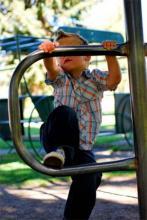
Motor skills refer to the development of motor control, precision, and accuracy in the performance of both fundamental and more complex movements.1 They involve the movement of the muscles in the body, which are divided into two groups: gross motor skills and fine motor skills. Gross motor skills use the larger movements of the arms, legs, feet, or the entire body when performing activities, such as crawling, running, and jumping. Fine motor skills are smaller actions using the hands, wrists, fingers, feet, toes, lips, and tongue to perform such activities as grasping objects or using the lips and tongue to taste objects. Both types of motor skills usually develop together, since coordination of these skills is required for many activities.2
The development of gross motor skills occurs mostly during childhood over a relatively short period of time. Encouraging the development of gross motor skills requires a safe, open play space with other children to interact with as well as some adult supervision. While there are developmental milestones that are observable, children reach these milestones at different rates and should be allowed to acquire both gross and fine motor skills at their own paces.3
Infants first learn to lift their heads and shoulders, then proceed gradually from rolling over to creeping on their stomachs and finally crawling. As they begin to climb and support their weight in a standing position, they develop the ability to walk.4 Fine motor skills for infants require eye-hand coordination and the ability to grasp an object. Their initial grasp is called the palmar grasp, which includes wrapping all the fingers and the thumb awkwardly around the object, making it difficult to manipulate. At about twelve months the pincer grip is developed holding objects between the thumb and index finger, which allows the infants to manipulate and grasp the objects better.5
Toddlers can run, climb stairs, and begin to kick and throw balls, although they will have difficulty catching balls.6 The fine motor skills become more sophisticated as they can scribble with crayons, turn book pages, and stack blocks. The dominance of either their right or left hand usually emerges at this stage.7
Preschoolers can hop, jump over objects, and catch and throw balls more precisely.8 Developing more delicate fine motor skills is a challenge that requires patience, which preschoolers have in short supply. Their central nervous system is still in the process of maturing to sufficiently relay complex messages from the brain to their fingers.9
By school age, children can ride bicycles, jump rope, and play a variety of games using balls, which require eye-hand coordination, visual perception, and coordination.10 They can draw, paint, make crafts, and put puzzles together. Children will continue to develop their fine motor skills through sports, hobbies, computer use, and learning musical instruments.11
Children progress in their development of both gross and fine motor skills as a result of a combination of brain maturation and muscle development. These skills are acquired gradually through continuous interaction and practice, and with enough practice become hard wired into them. Skill learning is a process that includes fast learning and slow learning. At first the child practices the task and performance improves gradually. Weeks later, after training has ended, there is usually significant improvement shown, which is known as the slow component of learning, where the brain has consolidated the skill. The new skill goes from active effort to automatic ability. Activities like riding a bicycle become hard wired into the brain, and the skill is retained for life.12
Motor skills are combined with perceptual, sensory skills, such as visual, auditory, and tactile abilities, to develop increasingly complex behaviors. Perceptual motor skills include body awareness, spatial awareness, directional awareness, and temporal awareness. Body awareness is the child’s understanding of his body parts, what they can do, and how to use them efficiently. Spatial awareness is the understanding of how much space the body occupies and how to use it in space. Directional awareness refers to understanding directionality and objects in space. Temporal awareness refers to understanding the relationship between movement and time, which includes rhythm and sequence.13
A child’s ability to perform gross motor skills is directly related to his physical fitness. If he is a competent mover, he will happily keep moving in activities, such as jumping rope, climbing trees, and swinging on the playground equipment. If a child feels uncoordinated and physically awkward, he is going to avoid movement and not actively pursue taking part in playing games or climbing the monkey bars. Poor movement habits tend to remain into adulthood causing a physically inactive child to grow up to be an inactive adult.14
- 1. Gallahue, David L. and Frances Cleland Donnelly. Developmental Physical Education for All Children. 4th ed. Champaign, IL: Human Kinetics. 2003. pp. 14-15.
- 2. “Fine Motor Skills.” Encyclopedia of Children’s Health. < http://www.healthofchildren.com/E-F/Fine-Motor-Skills.html > 22 Oct. 2010.
- 3. “Gross Motor Skills.” Encyclopedia of Children’s Health. < http://www.healthofchildren.com/G-H/Gross-Motor-Skills.html > 22 Oct. 2010.
- 4. Ibid.
- 5. Op. cit., “Fine Motor Skills.”
- 6. Op. cit., “Gross Motor Skills.”
- 7. Op. cit., “Fine Motor Skills.”
- 8. Op. cit., “Gross Motor Skills.”
- 9. Op. cit., “Fine Motor Skills.”
- 10. Op. cit., “Gross Motor Skills.”
- 11. Op. cit., “Fine Motor Skills.”
- 12. “Learning Motor Skills.” Brain Skills. < http://www.brainskills.co.us/LearningMotorSkills.html > 22 Oct. 2010.
- 13. Frost, Joe L., Sue Wortham, Stuart Reifel. Play and Child Development. Upper Saddle River, NJ: Prentice-Hall, Inc., 2001. p. 164.
- 14. Pica, Rae. “Why Motor Skills Matter.” National Association for the Education of Young Children. < http://www.naeyc.org/files/yc/file/200807/BTJLearningLeapsBounds.pdf > 22 Oct. 2010.

